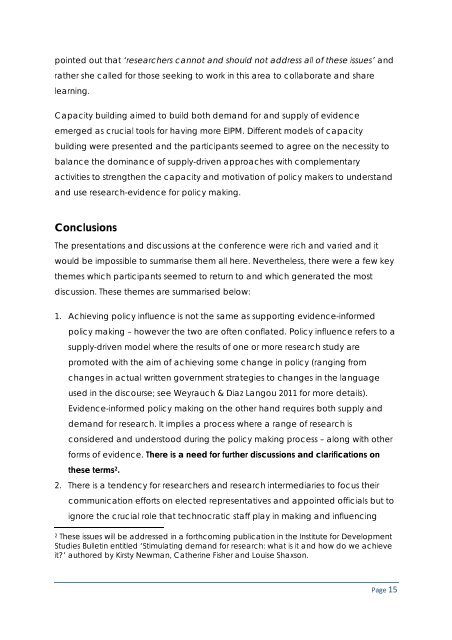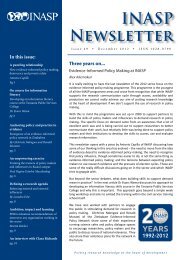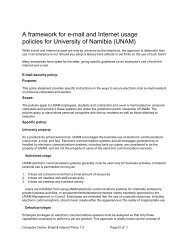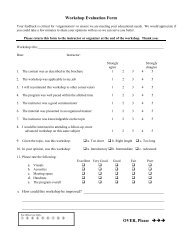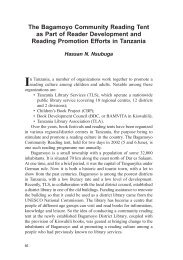What is the evidence on evidence-informed policy making? - INASP
What is the evidence on evidence-informed policy making? - INASP
What is the evidence on evidence-informed policy making? - INASP
You also want an ePaper? Increase the reach of your titles
YUMPU automatically turns print PDFs into web optimized ePapers that Google loves.
pointed out that ‘researchers cannot and should not address all of <str<strong>on</strong>g>the</str<strong>on</strong>g>se <str<strong>on</strong>g>is</str<strong>on</strong>g>sues’ and<br />
ra<str<strong>on</strong>g>the</str<strong>on</strong>g>r she called for those seeking to work in th<str<strong>on</strong>g>is</str<strong>on</strong>g> area to collaborate and share<br />
learning.<br />
Capacity building aimed to build both demand for and supply of <str<strong>on</strong>g>evidence</str<strong>on</strong>g><br />
emerged as crucial tools for having more EIPM. Different models of capacity<br />
building were presented and <str<strong>on</strong>g>the</str<strong>on</strong>g> participants seemed to agree <strong>on</strong> <str<strong>on</strong>g>the</str<strong>on</strong>g> necessity to<br />
balance <str<strong>on</strong>g>the</str<strong>on</strong>g> dominance of supply-driven approaches with complementary<br />
activities to streng<str<strong>on</strong>g>the</str<strong>on</strong>g>n <str<strong>on</strong>g>the</str<strong>on</strong>g> capacity and motivati<strong>on</strong> of <strong>policy</strong> makers to understand<br />
and use research-<str<strong>on</strong>g>evidence</str<strong>on</strong>g> for <strong>policy</strong> <strong>making</strong>.<br />
C<strong>on</strong>clusi<strong>on</strong>s<br />
The presentati<strong>on</strong>s and d<str<strong>on</strong>g>is</str<strong>on</strong>g>cussi<strong>on</strong>s at <str<strong>on</strong>g>the</str<strong>on</strong>g> c<strong>on</strong>ference were rich and varied and it<br />
would be impossible to summar<str<strong>on</strong>g>is</str<strong>on</strong>g>e <str<strong>on</strong>g>the</str<strong>on</strong>g>m all here. Never<str<strong>on</strong>g>the</str<strong>on</strong>g>less, <str<strong>on</strong>g>the</str<strong>on</strong>g>re were a few key<br />
<str<strong>on</strong>g>the</str<strong>on</strong>g>mes which participants seemed to return to and which generated <str<strong>on</strong>g>the</str<strong>on</strong>g> most<br />
d<str<strong>on</strong>g>is</str<strong>on</strong>g>cussi<strong>on</strong>. These <str<strong>on</strong>g>the</str<strong>on</strong>g>mes are summar<str<strong>on</strong>g>is</str<strong>on</strong>g>ed below:<br />
1. Achieving <strong>policy</strong> influence <str<strong>on</strong>g>is</str<strong>on</strong>g> not <str<strong>on</strong>g>the</str<strong>on</strong>g> same as supporting <str<strong>on</strong>g>evidence</str<strong>on</strong>g>-<strong>informed</strong><br />
<strong>policy</strong> <strong>making</strong> – however <str<strong>on</strong>g>the</str<strong>on</strong>g> two are often c<strong>on</strong>flated. Policy influence refers to a<br />
supply-driven model where <str<strong>on</strong>g>the</str<strong>on</strong>g> results of <strong>on</strong>e or more research study are<br />
promoted with <str<strong>on</strong>g>the</str<strong>on</strong>g> aim of achieving some change in <strong>policy</strong> (ranging from<br />
changes in actual written government strategies to changes in <str<strong>on</strong>g>the</str<strong>on</strong>g> language<br />
used in <str<strong>on</strong>g>the</str<strong>on</strong>g> d<str<strong>on</strong>g>is</str<strong>on</strong>g>course; see Weyrauch & Diaz Langou 2011 for more details).<br />
Evidence-<strong>informed</strong> <strong>policy</strong> <strong>making</strong> <strong>on</strong> <str<strong>on</strong>g>the</str<strong>on</strong>g> o<str<strong>on</strong>g>the</str<strong>on</strong>g>r hand requires both supply and<br />
demand for research. It implies a process where a range of research <str<strong>on</strong>g>is</str<strong>on</strong>g><br />
c<strong>on</strong>sidered and understood during <str<strong>on</strong>g>the</str<strong>on</strong>g> <strong>policy</strong> <strong>making</strong> process – al<strong>on</strong>g with o<str<strong>on</strong>g>the</str<strong>on</strong>g>r<br />
forms of <str<strong>on</strong>g>evidence</str<strong>on</strong>g>. There <str<strong>on</strong>g>is</str<strong>on</strong>g> a need for fur<str<strong>on</strong>g>the</str<strong>on</strong>g>r d<str<strong>on</strong>g>is</str<strong>on</strong>g>cussi<strong>on</strong>s and clarificati<strong>on</strong>s <strong>on</strong><br />
<str<strong>on</strong>g>the</str<strong>on</strong>g>se terms 2 .<br />
2. There <str<strong>on</strong>g>is</str<strong>on</strong>g> a tendency for researchers and research intermediaries to focus <str<strong>on</strong>g>the</str<strong>on</strong>g>ir<br />
communicati<strong>on</strong> efforts <strong>on</strong> elected representatives and appointed officials but to<br />
ignore <str<strong>on</strong>g>the</str<strong>on</strong>g> crucial role that technocratic staff play in <strong>making</strong> and influencing<br />
2 These <str<strong>on</strong>g>is</str<strong>on</strong>g>sues will be addressed in a forthcoming publicati<strong>on</strong> in <str<strong>on</strong>g>the</str<strong>on</strong>g> Institute for Development<br />
Studies Bulletin entitled ‘Stimulating demand for research: what <str<strong>on</strong>g>is</str<strong>on</strong>g> it and how do we achieve<br />
it’ authored by Kirsty Newman, Ca<str<strong>on</strong>g>the</str<strong>on</strong>g>rine F<str<strong>on</strong>g>is</str<strong>on</strong>g>her and Lou<str<strong>on</strong>g>is</str<strong>on</strong>g>e Shaxs<strong>on</strong>.<br />
Page 15


